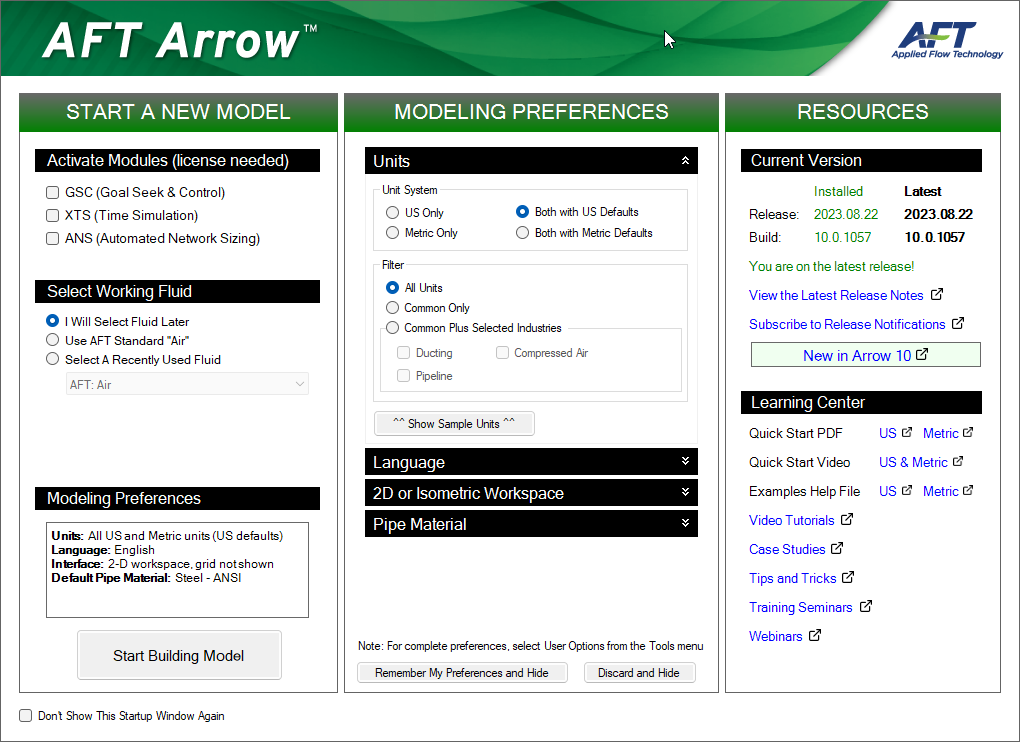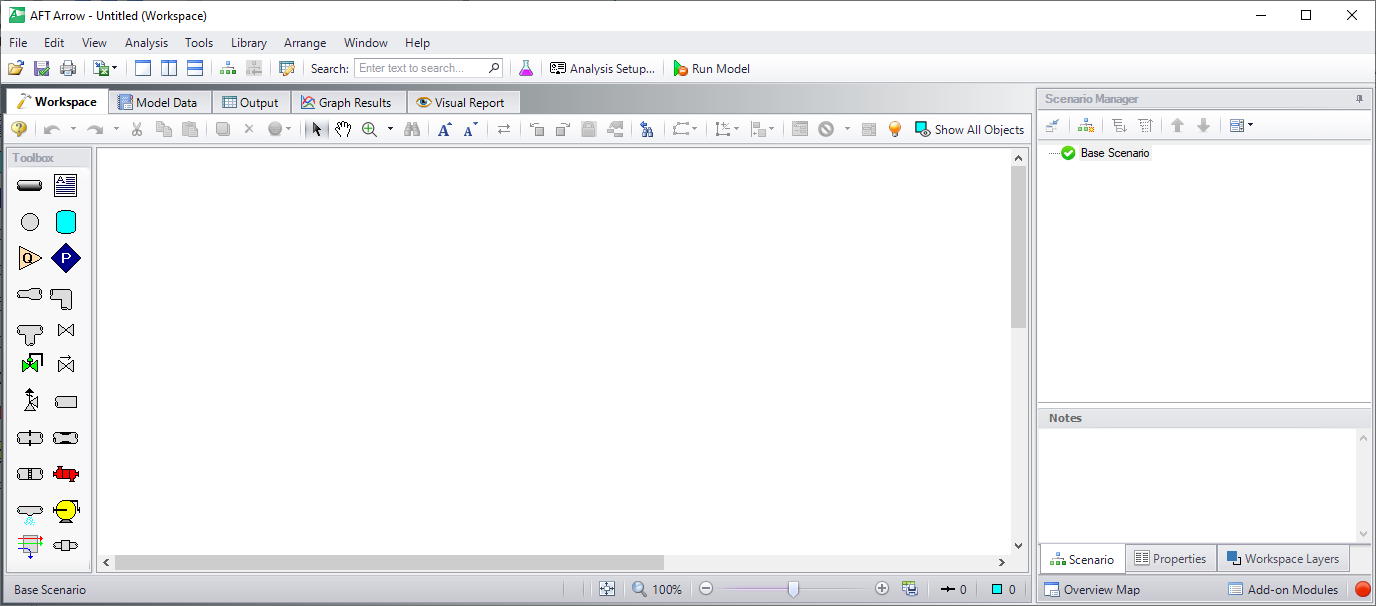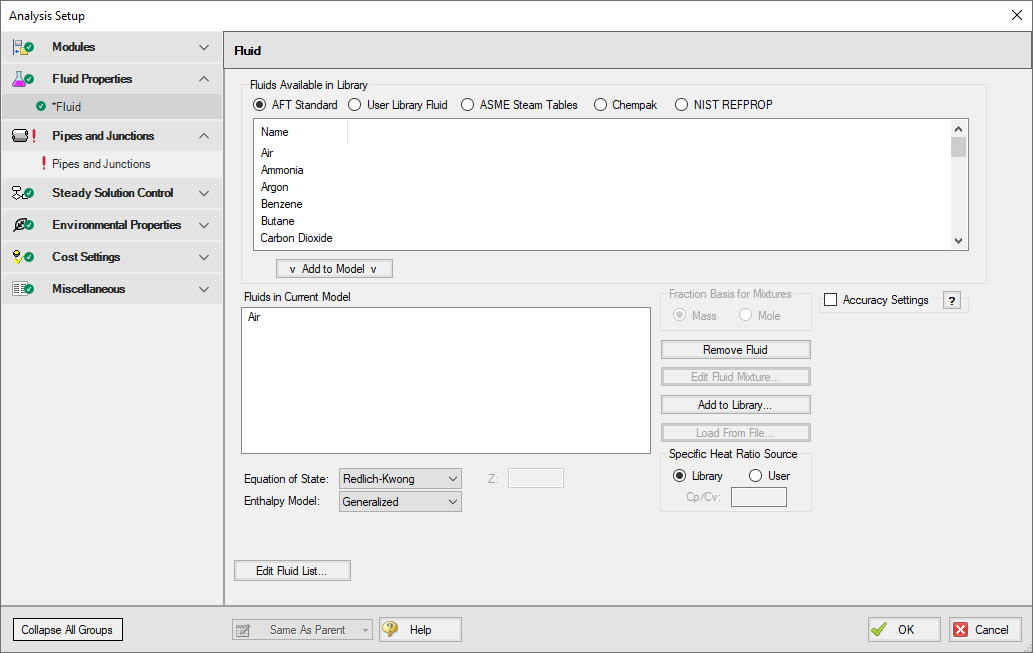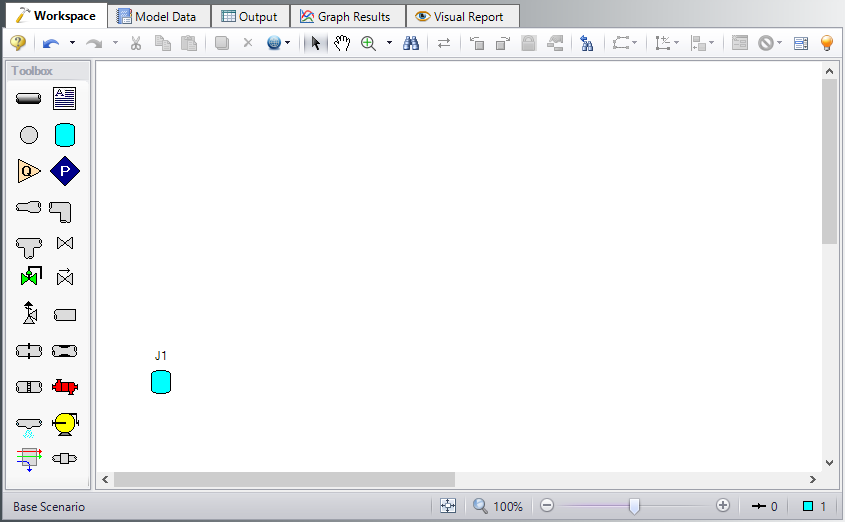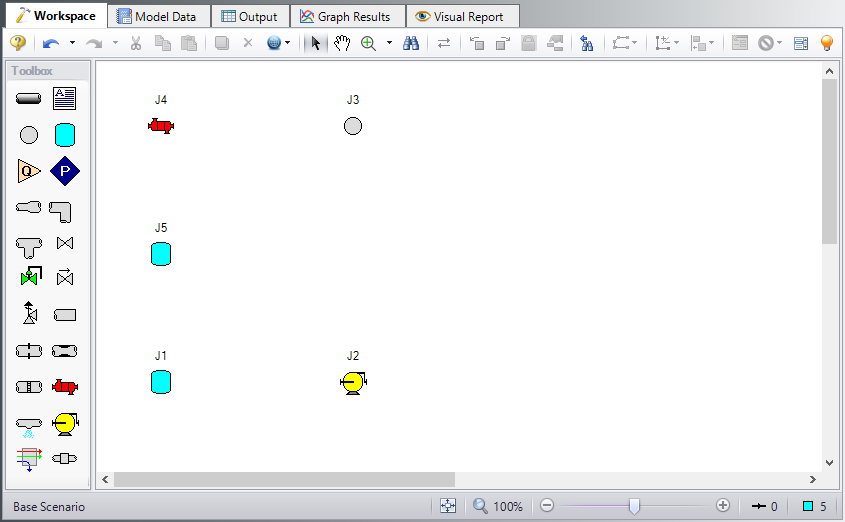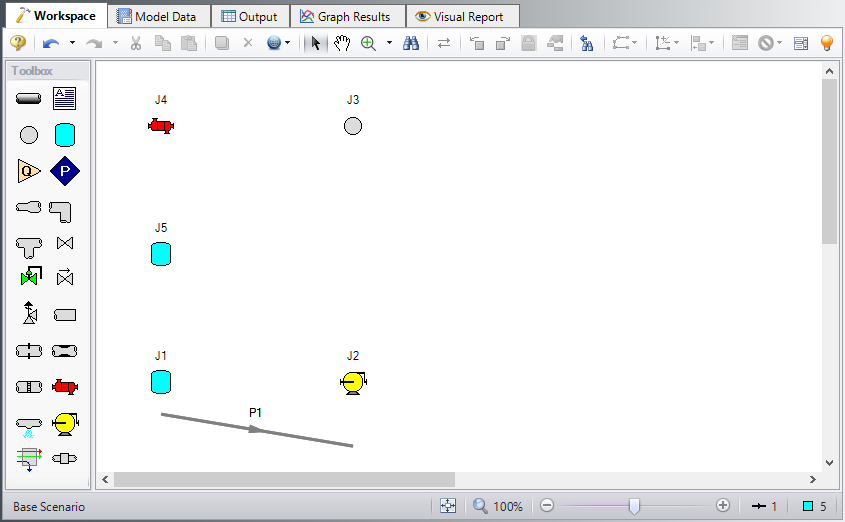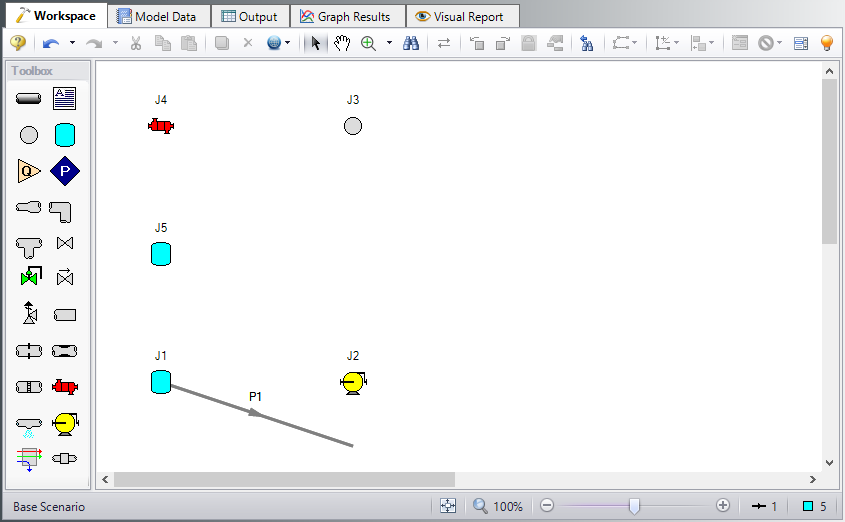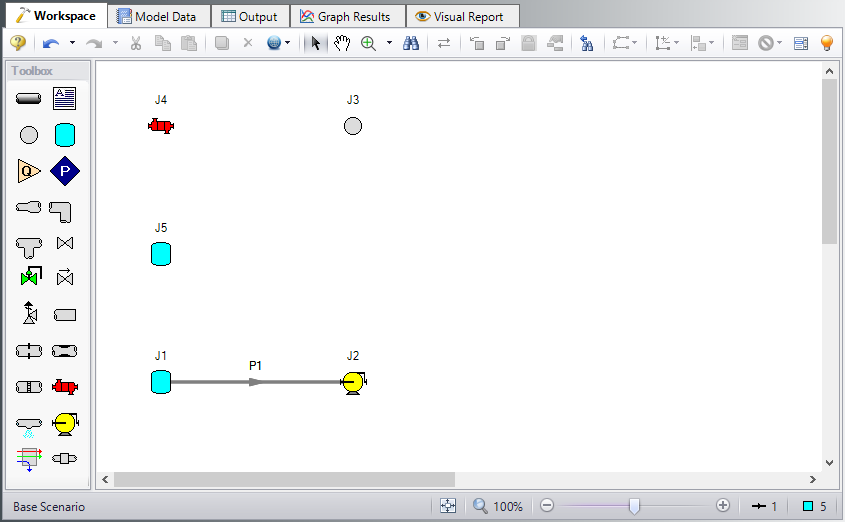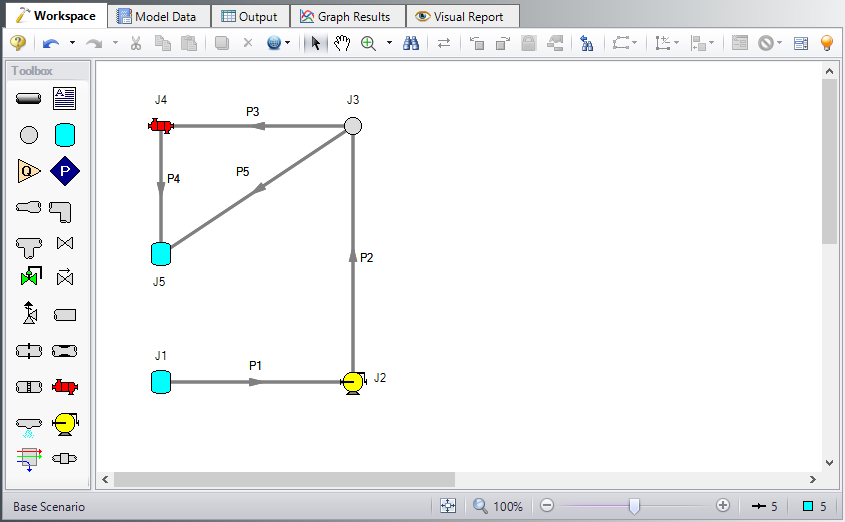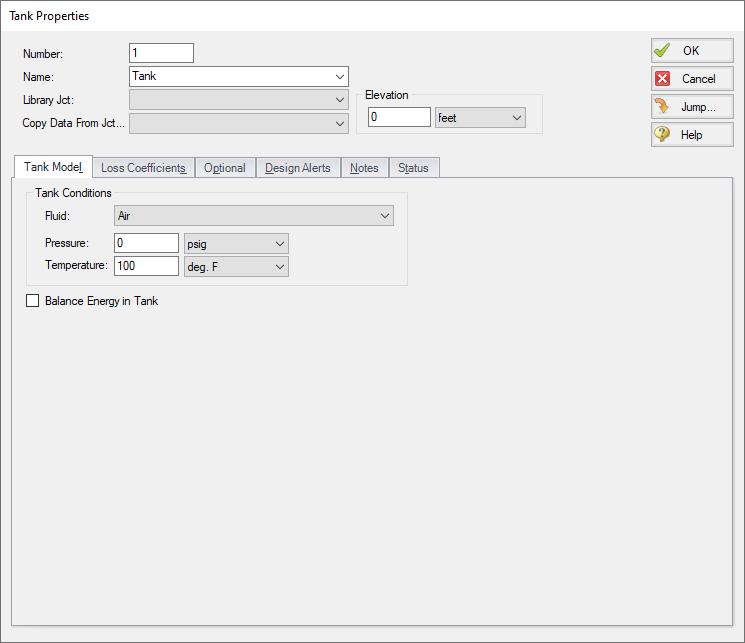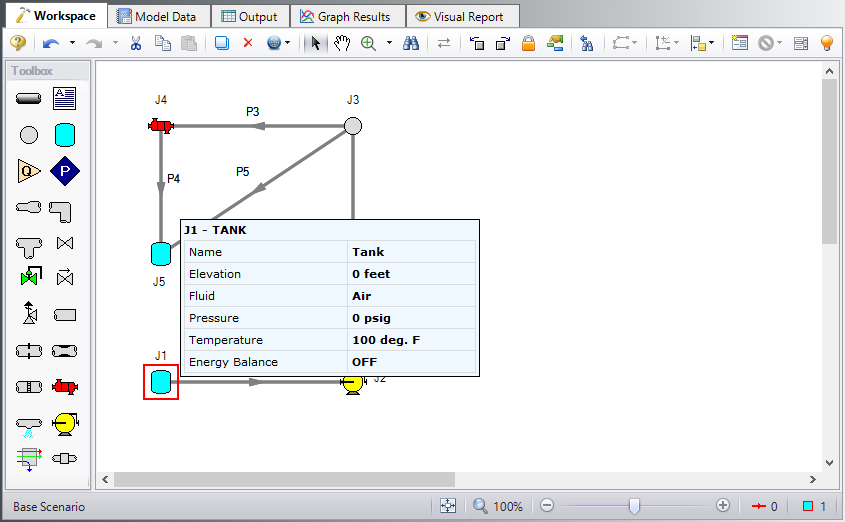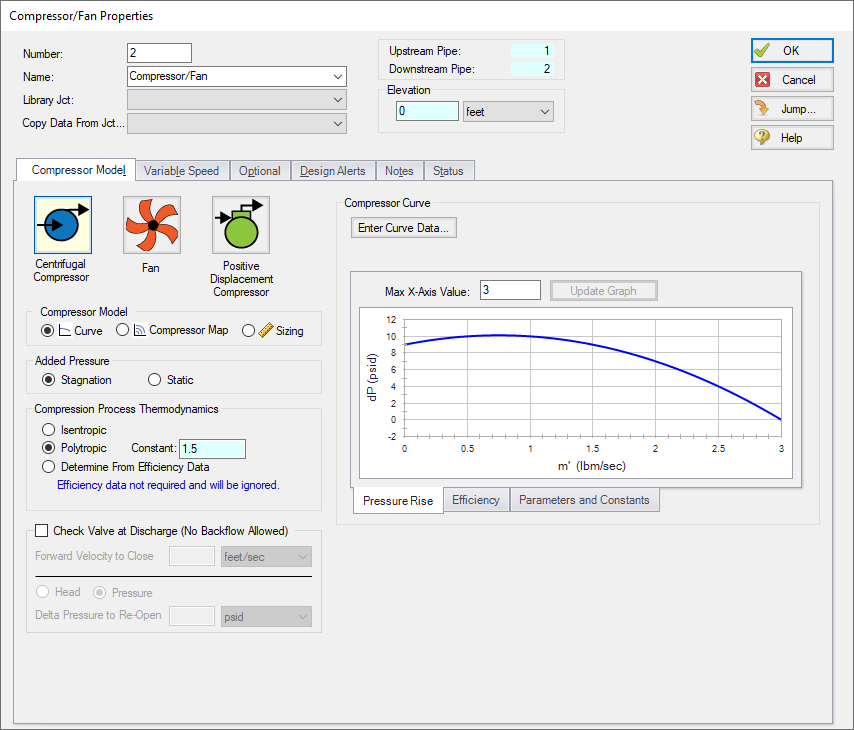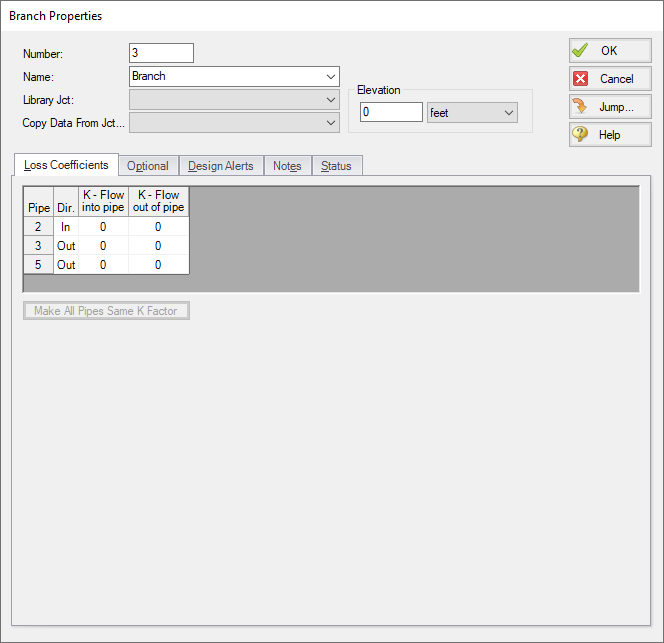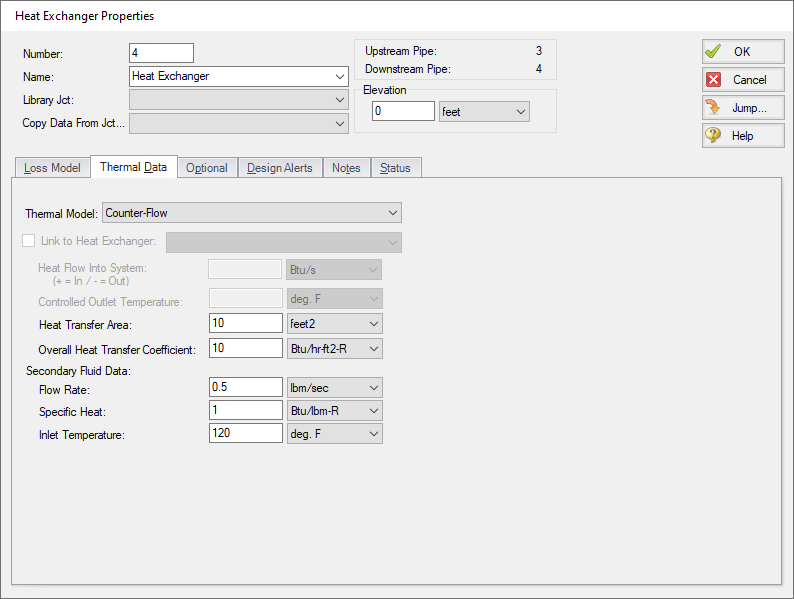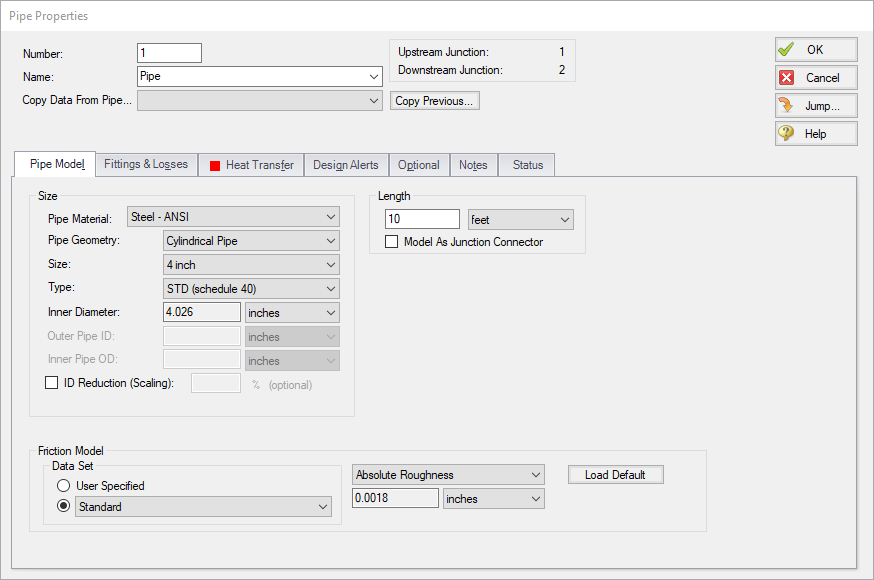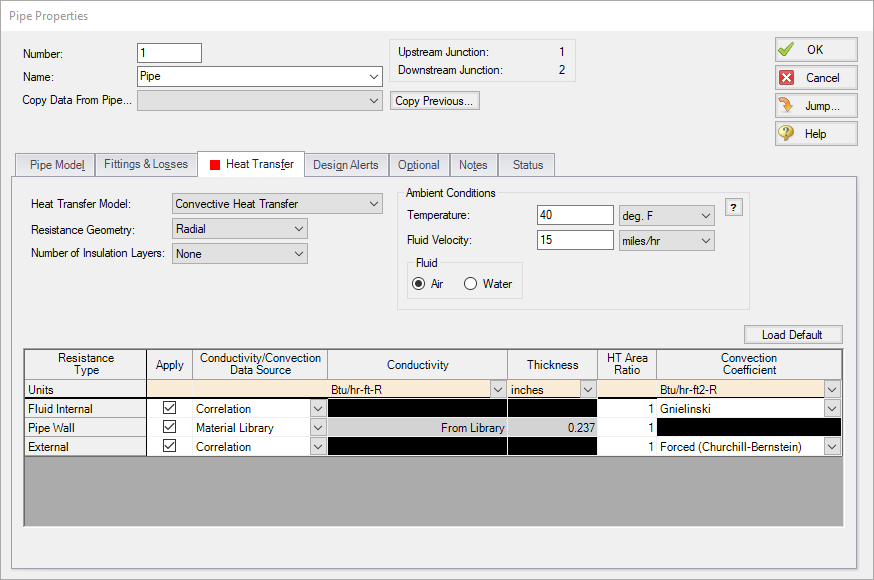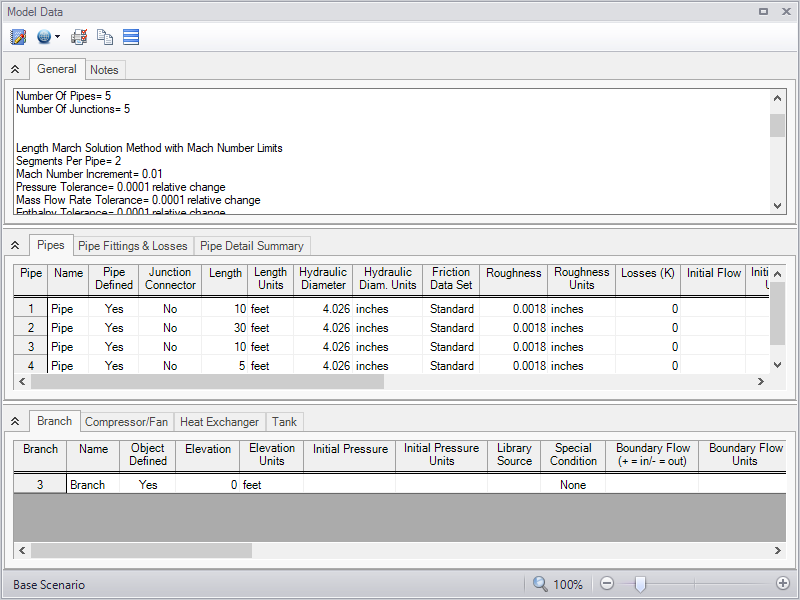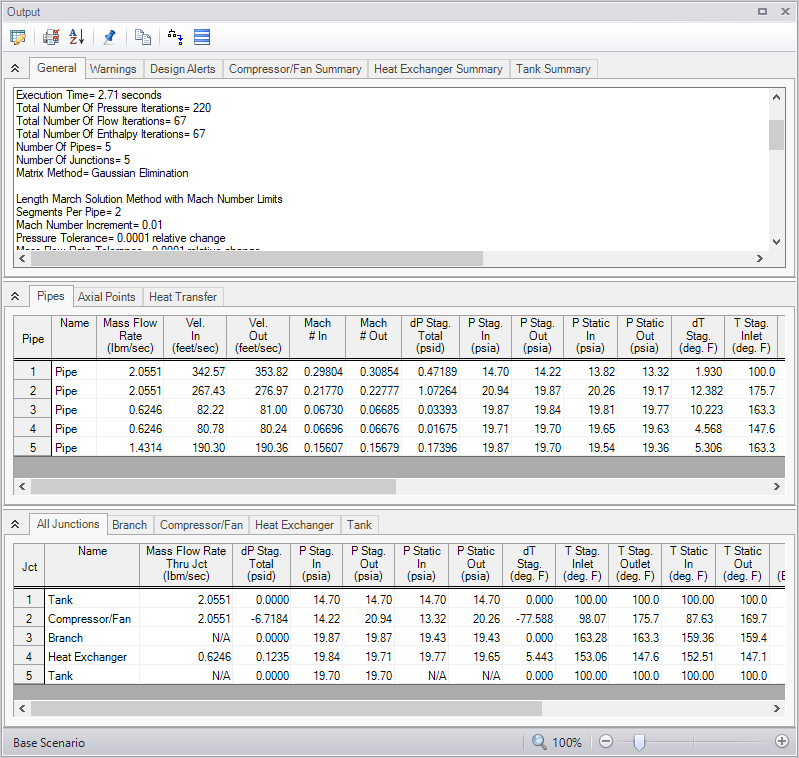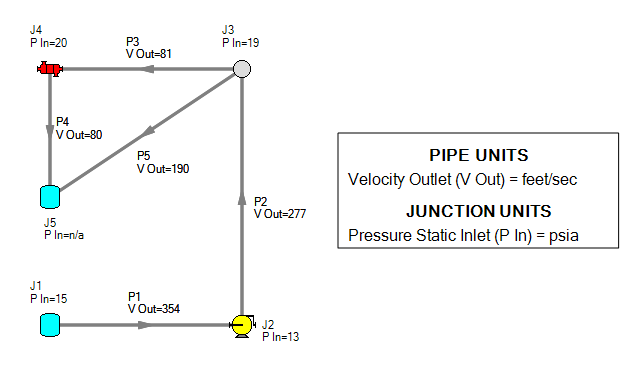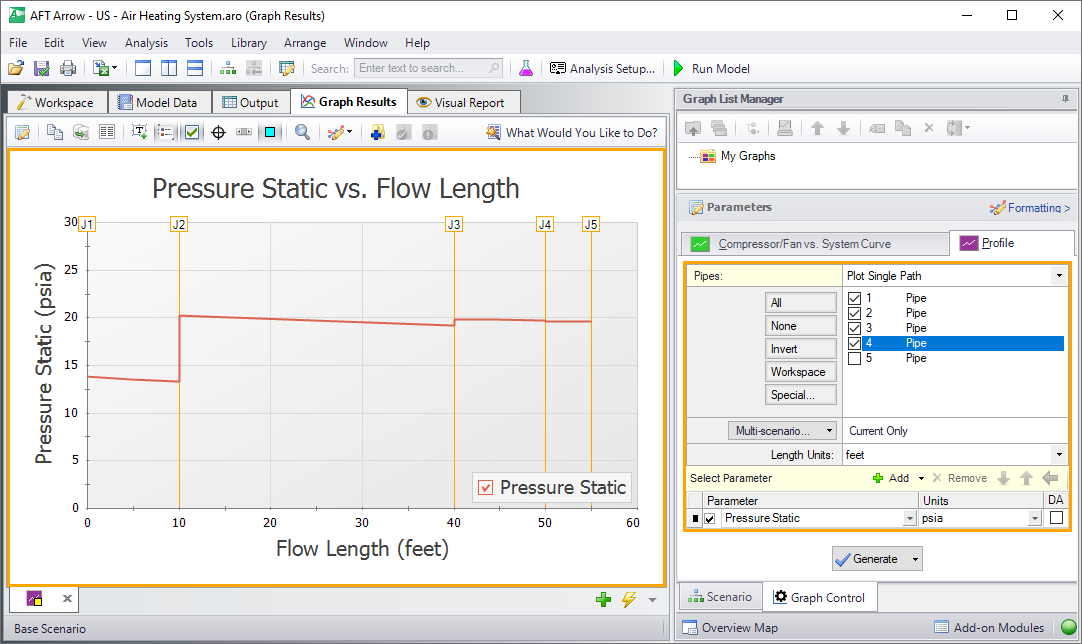Beginner - Air Heating System (English Units)
Beginner - Air Heating System (Metric Units)
Summary
This example is designed to demonstrate the big picture of AFT Arrow’s layout and structure. Some of the more basic concepts will be used to build a simple air heating system driven by a compressor.
Topics Covered
-
Completing Analysis Setup
-
Drawing the system with Pipes and Junctions
-
Entering Pipe and Junction properties
Required Knowledge
This example assumes the user has not used AFT Arrow previously. It begins with the most basic elements of laying out the pipes and junctions and solving hydraulic methodology.
Model File
This example uses the following file, which is installed in the Examples folder as part of the AFT Arrow installation:
Step 1. Start AFT Arrow
ØTo start AFT Arrow, click Start on the Windows taskbar, choose the AFT Arrow 10 folder from the all apps list, then click AFT Arrow 10 to launch the application. (This refers to the standard menu items created by setup. You may have chosen to specify a different menu item during installation.)
After AFT Arrow opens, the Start-Up screen, as shown in Figure 1, appears and provides you with several options before you start building a model. Some of the actions available are:
-
Open a recent model, browse to a model, or browse to an Example
-
Activate an Add-on Module
-
Select AFT Standard Air or a recently used fluid to be the Working Fluid
-
Review or modify Modeling Preferences
-
Select a Unit System
-
Filter units to include Common Only or Common Plus Selected Industries
-
Choose a Grid Style
-
Select a default Pipe Material
-
-
Access other Resources, such as Quick Start Guides, Help Files, and Video Tutorials
Note: If you are working through the Metric Units version of the Examples, be sure to specify either Metric Only or Both with Metric Defaults as the unit sets and check the box to Set as my Default.
Click Start Building Model on the Start-Up window, the Workspace window is always the active (large) window, as seen in Figure 2.The tabs in the AFT Arrow window represent the Primary Windows. Each Primary Window contains its own Toolbar that is displayed directly beneath the Primary Window tabs.
AFT Arrow supports dual monitor usage. You can click and drag any of the Primary Window tabs off of the main AFT Arrow window. Once you drag one of the Primary Windows off of the AFT Arrow window, you can move it anywhere you like on your screen, including onto a second monitor in a dual monitor configuration. To add the Primary Window back to the main AFT Arrow primary tab window bar, simply click the X button in the upper right of the Primary Window.
To ensure that your results are the same as those presented in this documentation, this example should be ran using all default AFT Arrow settings, unless you are specifically instructed to do otherwise.
The Workspace Window
The Workspace window is the primary vehicle for building your model. This window has three main areas: the Toolbox, the Quick Access Panel, and the Workspace itself. The Toolbox is the bundle of tools on the far left.
The Quick Access Panel is on the far right. It will be used later in this example to create Workspace Layers. It is possible to minimize the Quick Access Panel by clicking on the thumbtack pin in the upper right corner of the Quick Access Panel in order to allow for greater Workspace area.
The Workspace takes up the rest of the window.
You will build your pipe flow model on the Workspace using the Toolbox tools. At the top of the Toolbox is the Pipe Drawing Tool and the Annotation tool. The Pipe Drawing tool, on the upper left corner of the Toolbox, is used to draw new pipes on the Workspace. The Annotation tool allows you to create annotations and auxiliary graphics.
Below the two drawing tools are twenty icons that represent the different types of junctions available in AFT Arrow. Junctions are components that connect pipes and also influence the pressure or flow behavior of the pipe system. The twenty junction icons can be dragged from the Toolbox and dropped onto the Workspace.
When you hold your mouse pointer over any of the Toolbox tools, a tooltip identifies the tool's function.
Step 2. Complete the Analysis Setup
ØNext, click Analysis Setup on the Toolbar that runs across the top of the AFT Arrow window. This opens Analysis Setup (see Figure 3). Analysis Setup contains seven groups (additional groups will be displayed if the GSC, XTS, or ANS modules are active). Each group needs to be completed before AFT Arrow allows you to run the Solver.
Analysis Setup can also be accessed by clicking on the Status Light on the Quick Access Panel. Once Analysis Setup is complete, the Model Status Light then turns from red to green.

Figure 3: The Analysis Setup tracks the model’s status and allows users to specify required parameters
A. Define the Modules Group
Although Analysis Setup initially opens to the Fluid panel of the Fluid Properties group, the first group, Modules, always has a green check when you start AFT Arrow because there are no modules activated by default. No further input is required here.
B. Define the Fluid Properties Group
Next is the Fluid Properties group. This group allows you to choose a fluid, select an Equation of State, and select an Enthalpy Model. Start by clicking on Fluid to open the Fluid panel (see Figure 4).
You can select a fluid from the standard AFT Arrow fluid library (AFT Standard), select custom user-defined fluids from User Library Fluid, select ASME Steam Tables, or select multiple fluids and/or create mixtures using the Chempak library or NIST REFPROP library. Custom fluids are created by opening the Library Manager from the AFT Arrow Library menu or by clicking the Edit Fluid List button at the bottom of the Fluid panel and clicking Add New Fluid...
ØSelect AFT Standard, select Air, then click Add to Model (see Figure 4). Leave the Equation of State model as Redlich-Kwong and the Enthalpy Model as Generalized.
C. Define the Pipes and Junctions Group
In order to fully define this group, there needs to be pipes and junctions on the Workspace. To lay out the recirculating model, you will place five junctions on the Workspace. Then you will connect the junctions with pipes.
I. Place the tank
ØTo start, drag a tank junction from the Toolbox and drop it on the Workspace. Figure 5 shows the Workspace with one tank.
Objects and ID numbers
Items placed on the Workspace are called objects. All objects are derived directly or indirectly from the Toolbox. AFT Arrow uses three types of objects: pipes, junctions and annotations.
All pipe and junction objects on the Workspace have an associated ID number. For junctions, this number is, by default, placed directly above the junction and prefixed with the letter J. Pipe ID numbers are prefixed with the letter P. You can optionally choose to display either or both the ID number and the name of a pipe or junction. You also can drag the ID number/name text to a different location to improve visibility.
The tank you have created on the Workspace will take on the default ID number of 1. You can change this to any desired number greater than zero and up to 99,999.
Editing on the Workspace
Once on the Workspace, junction objects can be moved to new locations and edited with the features on the Edit menu. Duplicating, cutting, copying, and pasting are all supported.
II. Place the other junctions
If the new junction type you want to add already exists on the Workspace, you have the option of duplicating that junction. You do this by selecting the object on the Workspace and then either choosing Duplicate from the Edit menu or pressing Control+D on the keyboard.
Drag a compressor/fan junction from the Toolbox and drop it somewhere to the right of the tank (see Figure 6). Next drag a branch junction and locate it above the compressor, then drag a heat exchanger junction and locate it above the tank. Finally, drag another tank junction and place it above the first tank junction.
Note: The relative location of objects in AFT Arrow is not important. Distances and heights are defined through Pipe and Junction Property windows. The relative locations on the Workspace establish the connectivity of the objects, but have no bearing on the actual length or elevation relationships.
If the icons do not line up exactly, no problems will result. However, your model may have a nicer appearance if the icons line up. You can align the icons by using the align features or snap to grid option selected from the Arrange menu.
Your model should now appear similar to that shown in Figure 6.
ØBefore continuing, save the work you have done so far. Choose Save As... from the File menu and enter the file name Air Heating System and AFT Arrow will append the *.aro extension to the file name.
III. Draw a pipe between J1 and J2
Now that you have five junctions, you need to connect them with pipes.
ØTo create a pipe, click the Pipe Drawing Tool icon on the Toolbox. The pointer will change to a cross hair when you move it over the Workspace. Draw a pipe below the junctions, similar to that shown in Figure 7.
The pipe object on the Workspace has an ID number (P1) shown near the center of the pipe.
ØTo place the pipe between J1 and J2, use the mouse to grab the pipe in the center, drag it so that its left endpoint falls within the J1 Tank junction, then drop it there (see Figure 8). Next, grab the right endpoint of the pipe and stretch the pipe, dragging it until the endpoint terminates within the J2 Compressor/Fan junction (see Figure 9).
Reference positive flow direction
On each pipe is an arrow that indicates the reference positive flow direction for the pipe. AFT Arrow assigns a flow direction corresponding to the direction in which the pipe is drawn.
You can reverse the reference positive flow direction by choosing Reverse Direction from the Arrange menu or selecting the Reverse Pipe Direction button on the Workspace Toolbar.
The reference positive flow direction is used for reference purposes only and need not be the actual flow direction.
If the reference positive direction is the opposite of that obtained by the Solver, the output will show the flow rate as a negative number.
IV. Draw the remaining pipes
A faster way to add a pipe is to draw it directly between the desired junctions.
ØActivate the pipe drawing tool again, position the mouse pointer on the J2 compressor/fan, then press and hold the left mouse button. Stretch the pipe up to the J3 Branch then release the mouse button. Now draw a third pipe from the J3 Branch to the J4 Heat Exchanger, draw a fourth pipe from the J4 Heat Exchanger to the J5 Tank, and draw a fifth pipe from the J3 Branch to the J5 Tank. Your model should now look similar to Figure 10.
Tip: Double-click the Pipe Drawing Tool in order to draw multiple pipes at a time, then deactivate the Pipe Drawing Tool either by pressing the Esc key or single-clicking the Pipe Drawing Tool again.
At this point all the objects in the model are graphically connected. Save the model by selecting Save in the File menu or by clicking on the diskette button on the Toolbar.
Note: Some users find it desirable to lock objects to the Workspace once they have been placed. This prevents accidental movement and disruption of the connections. You can lock all the objects by choosing Select All from the Edit menu, then selecting Lock Object from the Arrange menu. The lock button on the Workspace Toolbar will appear depressed indicating it is in an enabled state, and will remain so as long as any selected object is locked. Alternatively, you can use the grid feature enabled in the User Options window from the Tools menu and specify that the pipes and junctions snap to grid.
V. Define the pipes and junctions
To fully define the Pipes and Junctions group in Analysis Setup, all pipes and junctions must be connected and have the proper input data.
Object status
Every pipe and junction has an object status. The object status tells you whether the object is defined according to AFT Arrow's requirements. To see the status of the objects in your model, click the flood light (Show Object Status) icon on the far right of the Workspace Toolbar (alternatively, you could choose Show Object Status from the View menu). Each time you click the light, Show Object Status is toggled on or off.
When Show Object Status is on, the ID numbers for all undefined pipes and junctions are displayed in red on the Workspace. Objects that are completely defined have their ID numbers displayed in black. (These colors are configurable through the User Options window from the Tools menu.)
Because you have not yet defined the pipes and junctions in this example, all the objects' ID numbers will change to red when you turn on Show Object Status.
Undefined Objects window
The Undefined Objects window lists all undefined pipes and junctions and further displays the items that are not yet defined.
VI. Define Tank J1
To define the first tank, open the J1 Tank Properties window by double-clicking on the J1 icon. The table on the Loss Coefficients should show you that Pipe 1 is connected to this tank.
Note: You can also open an object's Properties window by selecting the object (clicking on it) and then either pressing the Enter key or clicking the Open Pipe/Jct Window icon on the Workspace Toolbar.
ØEnter the Pressure as 0 psig. You can assign any unit of pressure found in the adjacent drop-down list box of units. Enter the Temperature as
Note: You can choose default units for many parameters (such as meters for length) in the User Options window.
You can give the component a name, if desired, by entering it in the Name field at the top of the window. By default, the junction’s name indicates the junction type. The name can be displayed on the Workspace or in the Output.
Most junction types can be entered into a custom library allowing the junction to be used multiple times or shared between users. To select a junction from the custom library, choose the desired junction from the Library Jct list. The current junction will get the input properties from the library.
The Copy Data From Junction… list will show all the junctions of the same type in the model. This will copy selected parameters from an existing junction in the model to the current junction.
Using the tabs in the Properties windows
The information in the Properties windows is grouped into several categories and are placed on separate tabs. Click a tab to bring its information forward. Figure 11 is an example of a Properties window with the Tank Model tab selected.
Click the Loss Coefficients tab to show the pipe table. The pipe table allows you to specify entrance and exit loss factors for each pipe connected to the tank (in this case there is only one). The default selection is the loss factors specified as zero. To later change the loss factors, click within the pipe table and enter the loss.
The Optional tab allows you to enter different types of optional data. You can select a junction icon from the included options or import your own to customize how a junction is displayed on the Workspace. Some junction types also allow you to specify an initial pressure and temperature, design factors, and other junction-specific data.
Each junction has a tab for notes, allowing you to enter text describing the junction or documenting any assumptions.
The Highlight feature displays all the required information in the Properties window in blue. The highlight is on by default. You can toggle the highlight off and on by pressing the F2 key. The highlight feature can also be turned on or off by selecting it on the User Options window. For the remainder of the examples, we will keep the highlight feature turned off.
ØClick OK. If Show Object Status is turned on, you should see the J1 ID number turn black again, telling you that J1 is now completely defined.
The Inspection Feature
You can check the input parameters for J1 quickly, in read-only fashion, by using the Inspection feature. Position the mouse pointer on the J1 tank icon and hold down the right mouse button. An information box appears, as shown in Figure 12.
Inspecting is a faster way of examining the input in an object rather than opening the Properties window.
VII. Define The Other Junctions
ØNext, open the properties window for Compressor/Fan J2 (see Figure 13). Several compressor/fan models are provided. You can enter a compressor curve, a compressor map, or set up the compressor in sizing mode with a fixed parameter such as a fixed mass flow rate or volumetric flow rate. A fixed flow rate will force the specified flow through the system and the resulting pressure rise will be calculated. A fixed pressure or head rise will apply the specified pressure or head at the compressor/fan and the resulting flow rate will then be calculated. A compressor/fan curve or a compressor map will model the actual performance of the compressor/fan. The pressure rise from a compressor/fan curve can be selected as either static or stagnation. The compression process models how the heat of compression affects the gas temperature, which is important in compressor applications.
For this example, use Centrifugal Compressor and select Compressor Curve as the Compressor Model. Click Enter Curve Data and enter the following data into the Compressor Configuration window:
| Mass | Pressure |
|---|---|
| lbm/sec | psid |
| 0 | 9 |
| 1 | 10 |
| 2 | 7 |
Click Generate Curve Fit Now and then click OK. Make sure the Added Pressure selection is set to Stagnation.
Set the Compression Process to Polytropic with a constant of 1.5. Last, enter an elevation of 0
ØOpen the Branch J3 properties window (see Figure 14). In this window, three connecting pipes should be displayed in the pipe table area. You can associate loss factors with each pipe by clicking within the pipe table and entering the data. These will be set to zero for this example.
ØEnter an elevation of 0 feet for the Branch J3 (an elevation must be defined for all junctions). You could also click the Optional tab and then specify a flow source or sink at the junction. For this example, we will not use the Flow Source or Sink option in the Optional tab. Click OK and the branch is now defined.
ØOpen the Heat Exchanger J4 Properties window. The thermal behavior of the heat exchanger is specified under the Thermal Data tab.
If you know the heat load for the exchanger, you can choose the Specified Heat Rate In thermal model and enter the heat rate directly. Adding heat to the system fluid is positive (i.e., heat flows out of the junction) while cooling is negative (heat flows into the junction).
You also have the option of choosing among a number of common heat exchanger configurations such as parallel and counter-flow. When you choose one of the other models, you must enter the secondary fluid conditions, heat exchanger area and heat transfer coefficient data. The secondary fluid can be either liquid or gas, although the models used to calculate heat transfer will be more accurate for liquids.
Whichever model is selected, the heat is added to or removed from the heat exchanger in accordance with the input model. The pressure drop through the heat exchanger is based on the Loss Model that is selected.
For this example, choose the Counter-Flow heat exchanger model with the following characteristics.
-
Heat Transfer Area = 10 feet2
-
Overall Heat Transfer Coefficient = 10 Btu/hr-ft2-R
-
Secondary Fluid Flow Rate = 0.5 lbm/sec
-
Secondary Fluid Specific Heat = 1 Btu/lbm-R
-
Secondary Fluid Inlet Temperature = 120 deg F
The Thermal Data tab should now look like see Figure 15.
ØGo to the Loss Model tab and specify the K factor at a value of 2. Enter an elevation of 0
ØOpen Tank J5 and enter a Pressure of
ØSave the model again before proceeding.
VIII. Define Pipe P1
The next step is to define all the pipes. To open the Pipe Properties window, double-click the pipe object on the Workspace.
ØFirst open the Pipe Properties window for Pipe P1 (see Figure 16). For Pipe P1 choose Steel - ANSI from the Pipe Material drop down menu, 4 inch for Size, STD (schedule 40) for the Type, and a length of
ØOn the Heat Transfer tab, select the Convective Heat Transfer model and for the Ambient Conditions, set the Temperature to
The Pipe Properties window
The Pipe Properties window offers control over all important flow and heat transfer parameters that are related to pipes.
The Inspection feature also works within the Pipe Properties window. To Inspect a connected junction, position the mouse pointer on the connected junction's ID number and hold down the right mouse button. This is helpful when you want to quickly check the properties of connecting objects. You can also use this feature in the junction properties windows for checking connected pipe properties.
By double-clicking the connected junction number, you can jump directly to the junction's properties window. Or you can click Jump to jump to any other part of your model.
IX. Define Other Pipes
ØOpen the Pipe Properties window for pipe P2 and choose pipe P1 from the Copy Data From Pipe drop-down menu (alternatively you can click the Copy Previous button). Choose all the properties and click OK. This will copy all pipe P1 input data to pipe P2. Then change the length of pipe P2 to
Open the other three Pipe Property windows and similarly copy all input data from pipe P1. Set the length of pipe P4 to
After completing the last pipe, all groups in Analysis Setup should be complete.
X. Check Pipes And Junctions
ØCheck if all the pipes and junctions are defined. If not, turn on the Show Object Status from the View menu and open each undefined pipe and junction. The Status tab will indicate what information is missing.
XI. Check Model Data
ØBefore running the model, save it to file one more time. It is also a good idea to review the input using the Model Data window.
Reviewing input in the Model Data window
The Model Data window is shown in Figure 18. To change to this window, you can select it from the Primary Window tabs or the Window menu, or by pressing CTRL+M. The Model Data window provides a tabular format for your model's input property data. Data in the Model Data window can be selected and then copied and pasted into other Windows programs, saved to a formatted file, printed to an Adobe PDF, or printed out for review.
Data is displayed in three general areas. The top area is called the General Section, the middle area is the Pipe Section, and the bottom area is the Junction Section.
The Model Data window allows access to all Properties windows by double-clicking the appropriate ID number in the far left column of the table. You may want to try this right now.
D. Define the remaining groups in Analysis Setup
Open Analysis Setup once more to confirm that all groups are defined. No inputs or alterations are required to complete the remaining groups: Steady Solution Control, Environmental Properties, Cost Settings, and Miscellaneous. All seven groups should have a green checkmark next to its name. Click OK.
Step 3. Run The Solver
ØChoose Run Model from the Toolbar or Analysis menu. During execution, the Solution Progress window displays (see Figure 19). You can use this window to pause or cancel the Solver's activity. When the solution is complete, the Output, Workspace, and Graphs Results windows can be accessed directly from the Solution Progress window. Click the Output button and the text-based Output window will appear (see Figure 20). The information in the Output window can be reviewed visually, saved to file, exported to a spreadsheet-ready format, copied to the clipboard, printed to an Adobe PDF file, and printed out on the printer.
Step 4. Examine the Output
The Output window is similar in structure to the Model Data window. Three areas are shown, and you can minimize or enlarge each area by clicking the arrow next to the General, Pipes, and Junctions tabs.
A. Specify Output Control
By default, AFT Arrow has a predefined set of Output Control parameters that are specified and the default units used depend on which unit set was selected when first running AFT Arrow (see Figure 1). A default title is also assigned in the Output Control.
ØOpen Output Control from the from the Common Toolbar or Tools menu. (Figure 21 shows the Output Control window). Click the General tab, enter a new title (if you like you can title this Air Heating System), then click OK to accept the title and other default data.
In addition, this window allows you to select the specific output parameters you want in your output from the Display Parameters tab. You also can choose the units for the output.
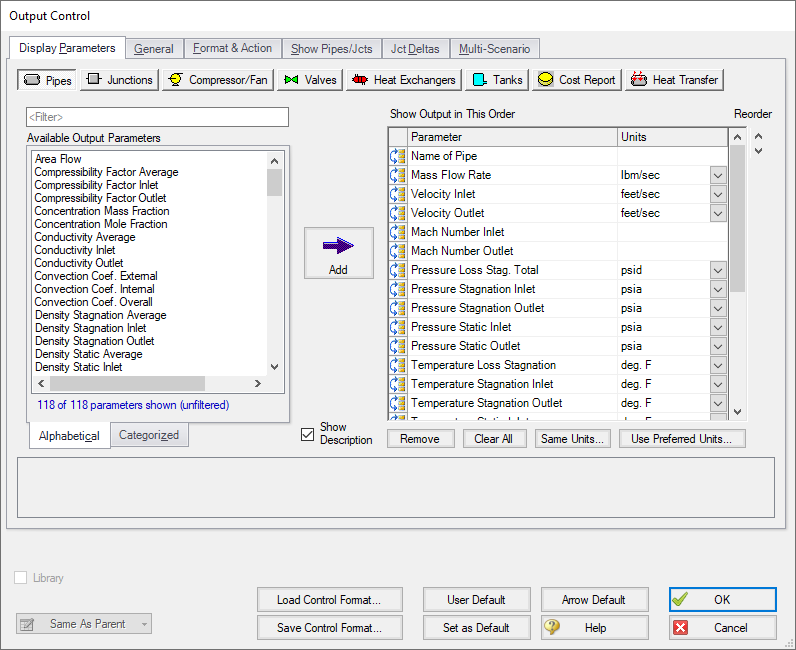
Figure 21: The Display Parameters tab allows you to customize which output data is displayed in AFT Arrow
B. Modify The Output Format
If you selected the default AFT Arrow Output Control, the Pipe Results table will show mass flow rate in the second column with units of
ØSelect Output Control from the Tools menu. On the right side of the Display Parameters tab for Pipes is the list of selected output parameters that will be displayed in the Output window. The left side shows all available parameters, including those that are not in the current output report but can be added at your option. You can view the list on the left either alphabetically or by categories by clicking the appropriate tab. On the list on the right, click Mass Flow Rate and change the units by selecting
ØClick OK to display changes to the current results. You should see the mass flow rate results, still in the second column, in units of
ØSelect Output Control from the Tools menu one more time. Select the Pipes in the Display Parameters tab. The parameters can be reordered by clicking the Reorder arrows on the right of the list, or by dragging the Reorder parameter icon on the left of the Output parameter you would like to reorder.
ØSelect the Velocity Inlet parameter and move it up to the top of the parameter list.
ØClick OK to display the changes to the current results. You will see in the Pipe results table that the first column now contains Vel. In (Velocity Inlet), the second column now contains the pipe name, and the third column the mass flow rate. The Output Control window allows you to obtain the parameters, units, and order you prefer in your output. This flexibility will help you work with AFT Arrow in the way that is most meaningful to you, reducing the possibility of errors.
ØLastly, double-click the column header for Vel. In in the Output window Pipe Results Table. This will open a window in which you can change the units once again if you prefer. These changes are extended to the Output Control parameter data you have previously set.
C. View The Results Using Workspace Layers
ØChange to the Workspace window by clicking the Workspace tab or by choosing it from the Window menu. Workspace Layers allow you to integrate your text results with the graphic layout of your pipe network from within the Workspace itself.
ØClick the Workspace Layers tab in the bottom right of the Quick Access Panel to view the Workspace Layers interface. Pipe and junction parameters can be added to new layers and applied to the labels of specified pipes or junctions as desired, or they can be added to the All Objects Layers. The All Objects Layer is a special default layer that displays all pipes, junctions, and annotations, and therefore any pipe and junction parameters added to this layer will be applied to all applicable pipes and junctions.
Note: It is typically preferable to create a new layer when adding a parameter to labels on the Workspace, but for the sake of simplicity, this example adds the parameters to the All Objects Layer.
Select the All Objects Layer and open its Layer Settings menu by clicking the gear icon in the Layers Toolbar (or to the right of the All Objects Layer's visibility icon) or by double clicking on the layer title.
Navigate to the Pipe Parameters panel within the Label Control group. Both input and output parameters are listed, though output parameters will only be displayed on the Workspace when output exists to do so. When no output exists, the output pipe label parameters in the right hand list will be gray. You can hover over each parameter to see a description of the parameter and whether it is an input or output parameter. Three categories of parameters will be listed to the left - Commonly Used Pipe Parameters, Pipe Parameters, and Pipe Heat Transfer Parameters. Expand the Pipe Parameters category and find the item Velocity Outlet. You can also use the parameter filter to search for desired parameters.
Note: Some parameter categories are contextual and may only appear in certain circumstances (when there is heat transfer in a model, when certain modules are active, when certain junctions are present, etc.).
ØAdd Velocity Outlet to the pipe label parameters by double clicking on it or single clicking it within the left hand list and pressing the arrow button in between the left-hand and right-hand lists to add it to the right-hand list, as shown in Figure 22. Leave the units as the default unit of
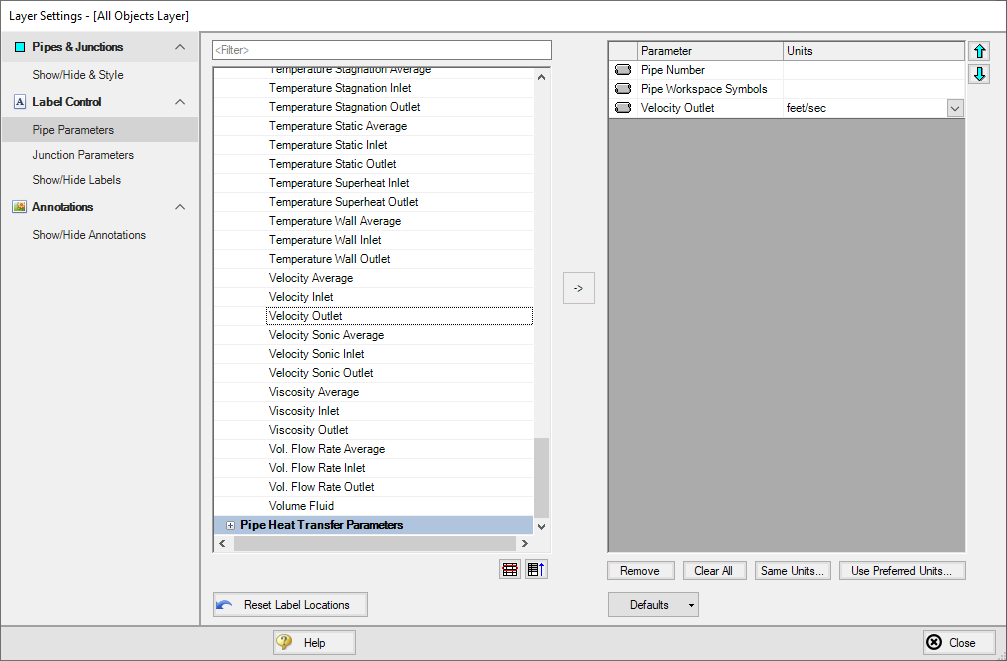
Figure 22: The Pipe Parameters panel in Layer Settings determines the parameters, their order, and their units for display in pipe labels on the Workspace
ØAdd Pressure Static Inlet to the junction label parameters in the same manner as before. It will be found in the Junction Parameters panel within the category Junction Parameters, as shown in Figure 23. Unlike the Tank Summary Parameters or Compressor/Fan Summary Parameters, which are specific to certain junction types, the Junction Parameters category is more general and will apply to labels for all types of junctions. The pressure unit may be left to its default value,

Figure 23: The Junction Parameters panel in Layer Settings determines the junction parameters, their order, and their units for display in junction labels on the Workspace
It is common for the text in the labels to overlap when first generated. You can change this by selecting smaller fonts in Global Layer Settings, where you can also show units in a legend to reduce clutter, or by dragging the text to a new area to increase clarity. In Figure 24, units have been moved to the legend and labels rearranged for better readability. The Workspace window and currently visible layers can be printed or copied to the clipboard for import into other Windows graphics programs, saved to a file, or printed to an Adobe PDF file.
D. Graph The Results
ØChange to the Graph Results window by clicking the Graph Results tab, choosing it from the Windows menu, or by pressing CTRL+G. The Graph Results window offers full-featured Windows plot preparation.
The Graph Parameters section will automatically be displayed in the Graph Control tab on the Quick Access Panel on the far right of the Graph Results window. The Graph Parameters section on the Graph Control tab is where you can specify which graphs you would like to generate. Multiple types of graphs can be generated such as Profiles, Compressor/Fan vs. System Curves, System Curves, or Multi-Scenario Graphs.
Select the Profile Graph tab in the Graph Parameters area in the Graph Control on the Quick Access Panel. Plot Single Path selected by default, select pipes P1 through P4 from the Pipes list. Choose Pressure Static, if not already selected, from the Parameter drop-down menu. Make sure
A graph appears showing the static pressure along the flow-path defined by pipes P1 through P4 in Figure 26.
You can use the other buttons in the Graph Results window to change the graph appearance and to save and export data for cross-plotting. The Graph Results window can be printed, saved to file, copied to the clipboard, or printed to an Adobe PDF file. The graph’s x-y data can be exported to file or copied to the clipboard.
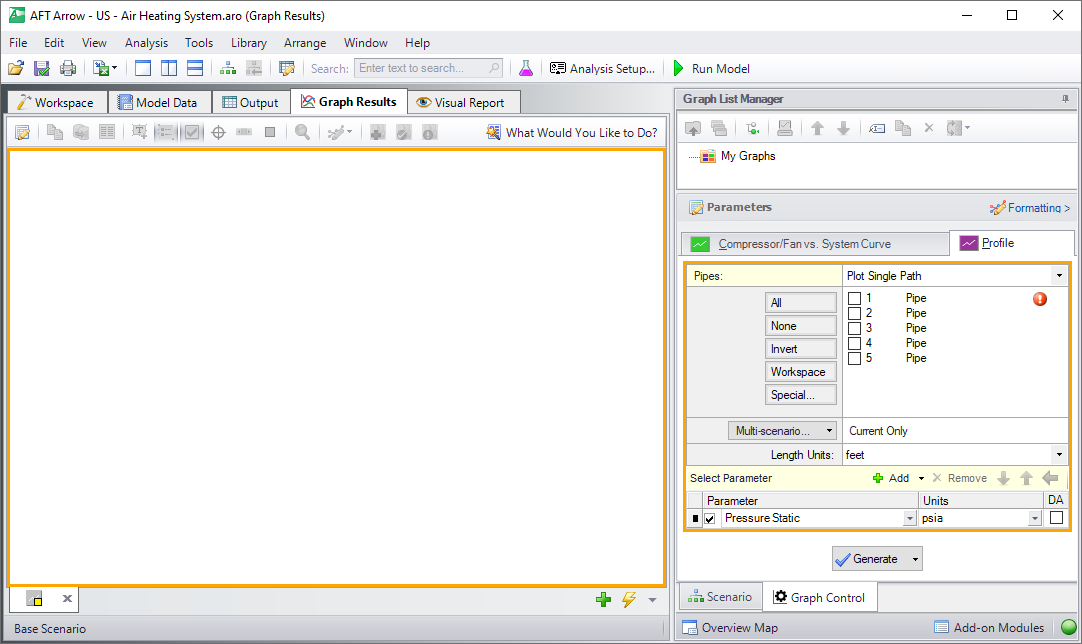
Figure 25: The Graph Parameters section of the Graph Control tab on the Quick Access Panel controls the Graph Results content
You have now used all of AFT Arrow's Primary Windows to build and analyze a simple model. Review the rest of the Arrow Help File contents for more detailed information on each of the windows and functions.
